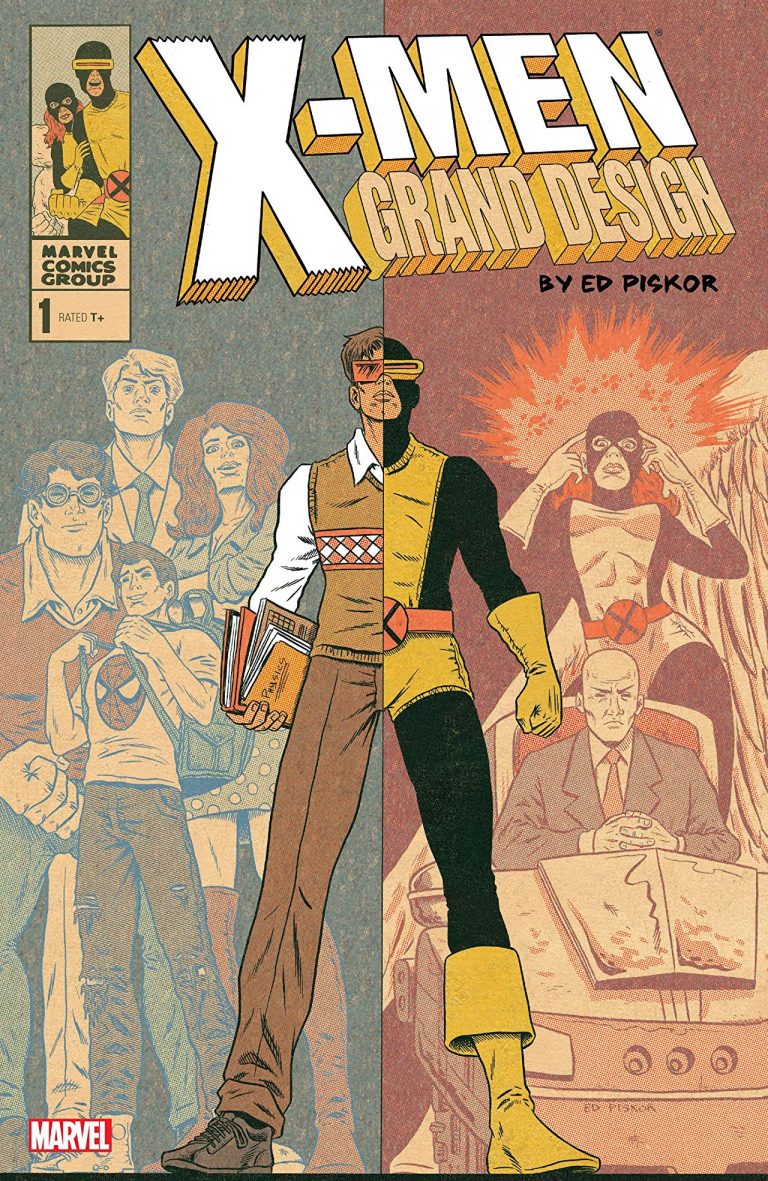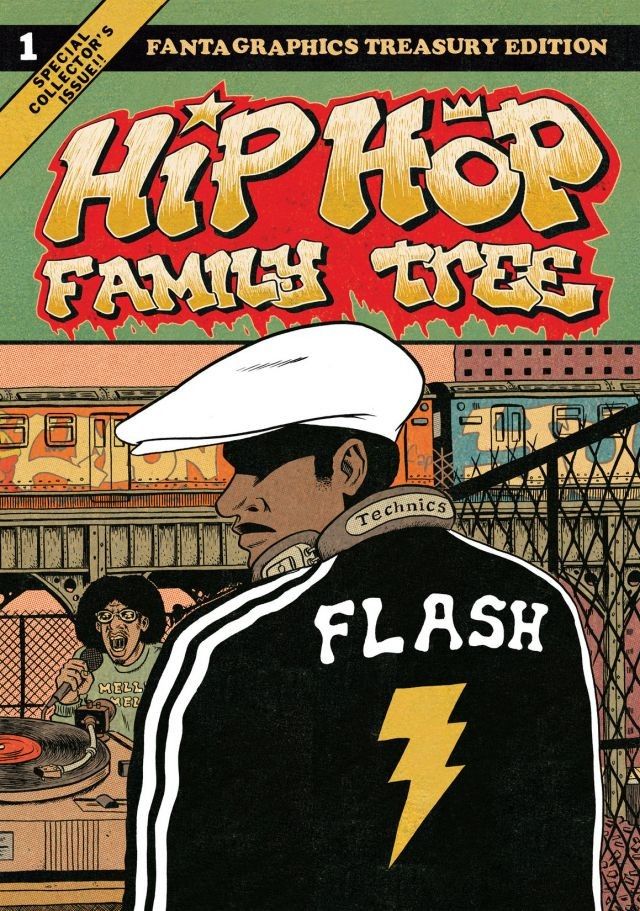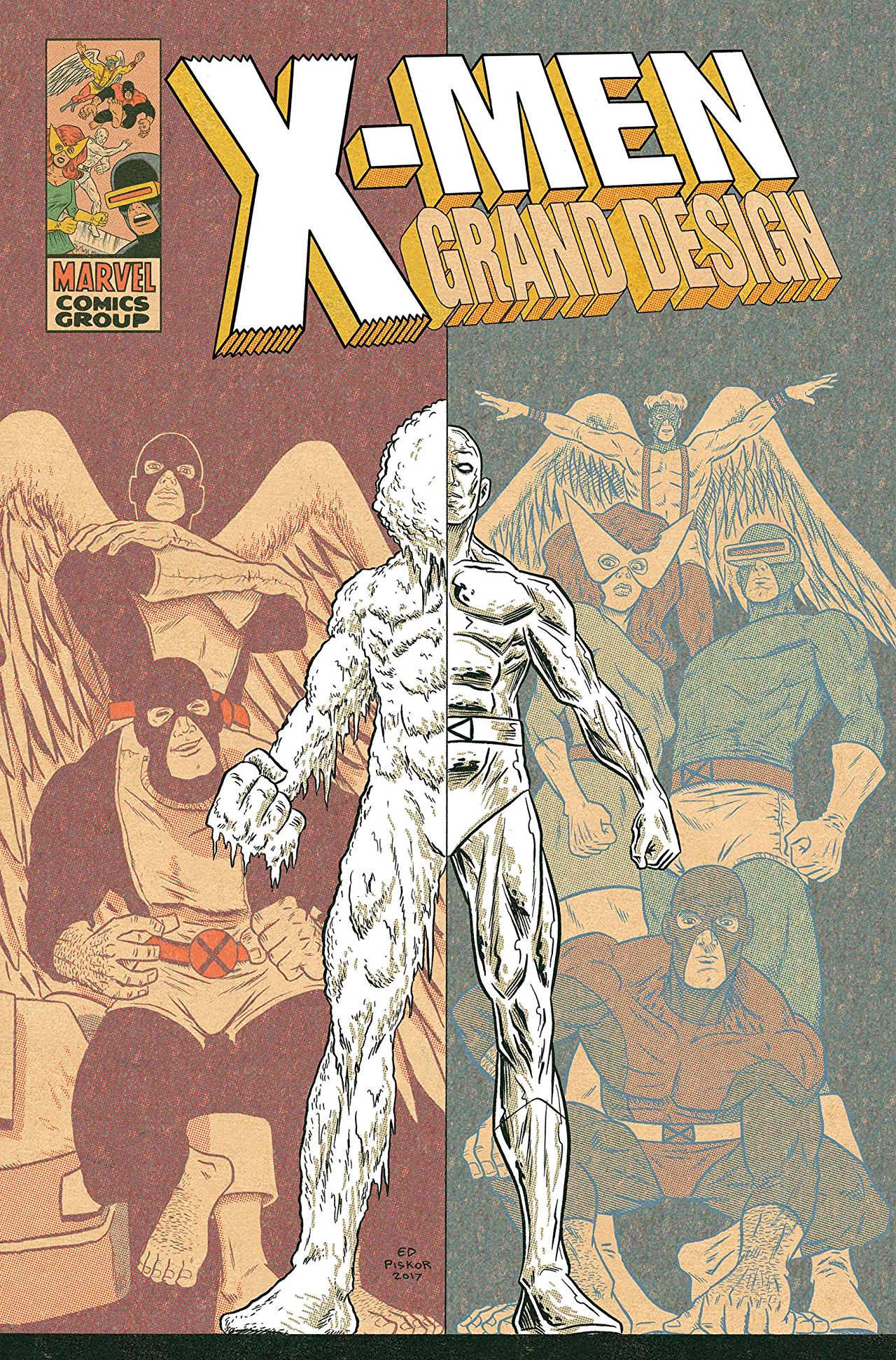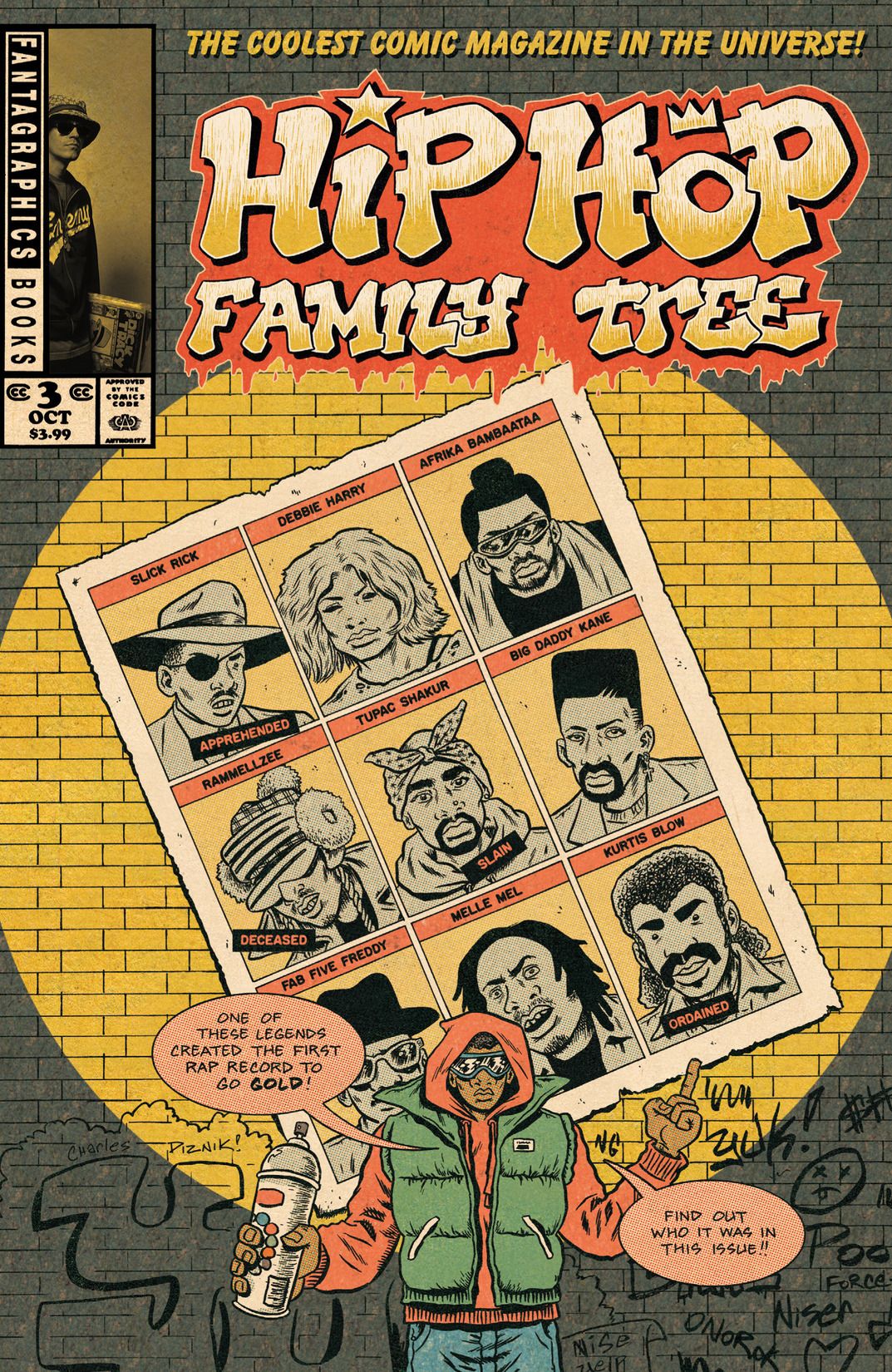Since bursting onto the scene in the late 2000s, Ed Piskor’s become one of the most visible new voices in cartooning, telling grounded stories with the gonzo energy of Silver Age superheroics.
After becoming a cult favorite with his Hip Hop Family Tree series, telling the story of the rise of the musical genre through stylish stories of rap’s pioneers, he landed the chance to retell the history of the X-Men with X-Men Grand Design, a six-issue maxi-series chronicling the first 300 issues of Uncanny X-Men that’s one part history and one-part testament to the series’ lauded focus on character.
Before the debut issue hits stands on Dec. 20, Piskor sat down to talk about modern mythology, Chris Claremont’s genius, Xavier’s villainy, and much more.
Tell me a little about your experience reading the X-Men growing up and your experience reading it today.
I was thinking about this earlier. It was the only constant in my life for the first 13, 14 years of my life. That’s no hyperbole. Some of my first memories are I had stacks of X-Men comics before I could read. I was able to get Classic X-Men and I was able to keep up with the comics month in and month out for most of my life. It was an integral part of my life, certainly my favorite Marvel comic growing up.
Do you remember your first one?

I do, it was issue #157 [Editor’s note: Uncanny X-Men #157: “Hide ’n’ Seek,” part of the Brood Saga storyline] and that was first grade, when I was able to read words myself. I remember asking my mom, “Chris Claremont, writer? Penciller, what does that mean?” She told me that people make these things and they’re not just cranked out of these machines.
From that point forward, the intention was always to go forward and hit a position where I could make and draw comic books. It just so happened that thanks to the Hip-Hop Family Tree comics, I hit a position that I could make the exact X-Men comic that I wanted to.
When I was in about 6th grade, Marvel put out the Marvel Universe Index to the X-Men. It was a five issue thing. At that time, it was the height of the speculation boom and all those old comics cost so much money and you didn’t have access to those [Jack] Kirby X-Men in any reasonable way, so I used those indexes to piece together the narratives.
Around that time, I knew how the “Marvel method” worked so I spent my middle school and high school years making X-Men comics using those synopsis. This Grand Design comic is a truncated version of what I was doing as a boy. It’s been fun. It’s one of those rare opportunities where I think you can honestly say that this mainstream effort is a dream project for the creator. That doesn’t happen often in mainstream comics. This is something that has been 35 years in development.
Reading that first issue, I wondered why certain things were structured the way they are but now they make sense. We see Cyclops’ parents’ plane blow up and then his dad is a Starjammer. Was that kind of your approach to combining all of the continuity at once?
Well the idea is to take 25, 30 issues worth of comics serialized monthly and turn it into a graphic novel, take away all the redundancies, take away a lot of the deus ex machina. For instance, let’s not have it be 25, 30 issues before you find out Scott Summers has a brother. Let’s build all that in early so it’s not just some way for the writers to keep excitement up with that sort of thing.
In this day and age there’s this cultural shift where, if you’ve ever listened to something like Dan Carlin’s Hardcore History or this great 9-minute history of Japan on YouTube, there’s room for these truncated histories to exist. I consider X-Men to be a modern mythology and mythology only works if it’s passed down from generation to generation by word of mouth. This is an instance of me keeping the conversation going.
There is so much X-Men stuff out there. What was your research process like getting together a blueprint of moments you wanted to hit and where you wanted to start?
Initially, what I needed to do was decide how many issues were going to be encapsulated in an issue of my comic. The idea that I presented to Marvel was to do this in 300 pages and the idea was to do 1 page per issue.
They came back and said they were more comfortable giving me 240 pages, so that meant I initially had to do a lot of editing any how but to have 60 less pages to play with meant I had to do more whittling down anyway. I figured out which issues were going to appear in my comic and from then the idea was to go back, reread all of the stuff that I would put into each given issue.
At least so far, when you read all of that stuff at once, you can imagine an arc taking place that probably wasn’t put there with intention but it shook out that way anyway. My comic will lean on these characters arcs and that will be the structure and sinew that the entire rest of the story develops around.
I have the benefit of foresight and hindsight by having all this material already in existence. I consider all that to be research development for my book. Those first three decades of X-Men comics are millions of dollars of research for me to move forward to make my work. Each issue takes about a month to write to get everything in the order that I want it so that I can draw the thing.
What stuff did you feel like you had to cut that you would have loved to get in if you had those other 60 pages?
At this point right now, the book is pretty comprehensive. In the last two issues, it’s absolutely going to have to be truncated a little more. The character stuff is always going to be more important to me than just the wonton violence or the battles or whatever.
If I was able to keep or explore anything more, it would just be more character moments, to give them more nuance and more personality but you can always refer to the original issues for that sort of thing, I’m just a big fan and a big sucker for the Chris Claremont soap opera of the thing.
Is that your favorite run?
Sure. It’s the stuff I know quite intimately. I had to edit a lot of stuff for my own taste in the early run.
Like the Stan and Jack run?
Yeah, certainly that. [Laughs] In issue, maybe, #3, Professor X laments that he can’t express his love for Jean Grey. You remember that?
Yeah, it’s in 3 or 4. [Editor’s Note: Ed was correct, it’s X-Men #3]
Yeah and it’s established that these kids are teenagers so it’s the pederast creepy sort of thing. You just make no mention of that. It just doesn’t exist.
Claremont, if you’ve ever heard him talk about his run, he doesn’t talk about panel this or issue that, he talks about Kitty Pryde. He talks about them as characters. You really have the sense that he believes in them. They’re people in his mind. I really like that. I aspire to make comics that feel that real to me.
Was there any hope to get in stuff like New Mutants or Excalibur or the side books like that into Grand Design?
I’m just moving into that realm now and y’know, I guess to answer an early question, if I had more pages, I’d put more of that stuff in the thing. I’d like it to be a more all encompassing X-book where I could put in the New Mutants and stuff like that. That probably answers your earlier question better.
There isn’t much room for stuff like that but I am moving into that space now where some of it has to come in here. I can’t abruptly have the Angel and then have Archangel on the next page.
You can’t really do “Inferno” without Illyana.
Yeah, yeah, yeah. That’s the can of worms right, that’s Madelyn Pryor, you have to establish her and turn her into the Goblin Queen. More than comics making or art, one of the skills I’ve had to develop for this is just the ability to be a really good editor and a really good curator. It’s going to take a lot of effort to make those last few issues work, to make all of that hyperbolic stuff work with the rest of the comics.
Has your approach to editing and putting things together changed from when you were doing Hip-Hop Family Tree?

To some extent, because, certainly, I don’t have Wolverine to worry about suing me so I can fudge the details a little bit and make them work for my own narrative. I’m prepared for some flag-waving fanboys to cry and say, “This didn’t happen this way,” or whatever. The exercise is just to make a damn comic in all this stuff. The answer to that kind of fanboyishness is, “I’m not going to come to your house and burn your comics collection. Your stuff still exists.”
I’m thinking of the new audience. I mean, the idea that there are people into the Avengers is crazy because, you know, who cares about that when you have the X-Men. I have to reinforce to this new generation why the X-Men are cool. I’m just never interested in playing in the same sandbox as people who are already comics fans.
With [Hip Hop Family Tree], I totally created a new audience of people who will continue to read new comics and, before that, I did a comic about computer hacking [Editor’s Note: Wizzywig is the comic] and I had an audience outside of comics for that. I’m trying to get people interested in the idea of X-Men and this is a very lightweight way to introduce all that continuity at once.
I know it’s going to be something you approach at some point but how do you approach a character whose continuity is so tangled like Cable or Wolverine. Their character has changed so much and been retconned so many times over the years, how do you approach a streamlined version of the character?
The cool thing about my script is that, in my mind, the X-Men ends with Claremont. When he left, there was kind of a methadone stage where I kept buying the comic out of inertia but going back and reading the Fabian Nicieza or the Scott Lobdell stuff, y’know there’s nothing I can do with that stuff.
After that, I just never read it so all that retcon that you speak of is just totally foreign. It’s easy in that respect. I did give [Wolverine] the bone claws in that first issue and that’s not a Claremont thing [Editor’s Note: Wolverine’s bone claws were revealed at the end of the “Fatal Attractions” crossover in 1993].
I just kind of take these things one page at a time and in a novelistic sense it’s ok if you leave a couple things obscure and let the reader read into certain things. That’s totally acceptable. The old notion of comics, that even as a five year old I despised, was to treat your readers like idiots, have double-triple redundancy when you’re trying to get a point across.
We just have a more sophisticated audience at large. They’re so much smarter. It’s easier to leave stuff open ended or leave open questions, so I allow that to take place in the book as well.
Is there anything people should be looking out for in that vein? Anything they’ll take notice of or ask questions about?
As an artist, you really have to be vulnerable. I put a lot of stuff in there but it’s only successful if the reader picks up on it, so I don’t have a lot to say. My hope is that it’s a rich enough experience that people want to explore it and come back to it or that it demands a deeper read or a reread.
It’s ok if you don’t get everything the first time, read it again.
You mentioned focusing on characters and in the first issue there’s a lot of focus on Xavier and Magneto. They’re both drawn similarly even, they’re both in big, similar helmets a lot and there’s a lot about their conflicts. How do you see those characters, both when they’re working together and when they’re working against each other?

I think probably the biggest challenge in creating the whole book is the notion of there is no absolute evil; that idea is silly. The idea is to give everybody a purpose and not just have some creeper who’s trying to rule the world or something.
There’s a lot more subtlety in this world and that’s how I look at both of those characters. I mean, you can look at Xavier as a villain even more wretched than Magneto in a lot of ways. He’s taking these teenage kids and putting them in peril.
Yeah, we spend a lot of time in the first issue with how he treats Moira and what he does that leads to David being such a problem later.
Yeah, I mean who isn’t a misguided do-gooder? I mean, you know, what is it they say, “the road to hell is paved with good intentions,” and there’s a duality there’s a tandem between Magneto and Xavier and Magneto’s just slightly more aggressive because he’s willing to kill people. But, y’know, in the early issues and in my comic, Xavier kills that Jack of Diamonds guy so he’s got blood on his hands.
I know you’re finishing up the series now but are there any other Marvel teams you’d be thinking about doing this same historic retrospective or would there be the next 300 X-Men issues.
[Laughs] There definitely would not be the next 300 because I just have no interest in that at all, but I would go back and do everybody. It would be cool to do the Spider-Man one or a Wolverine one to flesh him out a little further. I would have a ball doing that. I would love to do a Batman one maybe.
Mark my words, if this thing is a hit and this thing catches on, I won’t be able to get this thing done fast enough before a bunch of Grand Designs pop up. These are corporations we’re working within the confines of and if something makes money they’re going to replicate that quick.
Remember in the ‘90s when there was Spider-Man #1 and then X-Force #1 and then X-Men #1 and then what’d they do to replicate off that success? Thunderstrike #1 and Silver Sable #1.
That was when I started reading. One of my first issues was X-Men #2.
That’s why I wouldn’t mind seeing more. It’d make me look sexier because I’m pretty sure they would suck in comparison with mine but it would be fun to explore that stuff further. I have a lot of affinity for the Big Two but I would have to do it in my own way where they kind of just allow me to do my thing.
We just put the first two issues to bed and I wrapped up the design for the first trade. These are books that are turning out exactly the way I wanted them to. If they’re a success I can take the lion share of the credit and if they fail, same thing, man. It’s all my fault then because the editors are all on my side.
Do you think there’s anything about the X-Men as a franchise that makes a project like this work in the way that I’d say it’d be a harder read or less interesting for the Avengers or the FF?

The series just completely benefitted from having the same writer working on it for 15 years. [Claremont] had it all swirling around in his head, it had a true consistency to it. And that is unique compared to every other mainstream comic.
It feels very male to have another writer come in and put their own stamp on it and take things over and that’s where you get retconning and laughing off of the earlier ideas. When you have the same guy working on the thing for damn near two decades, there’s a natural kind of energy that’s in there that would only exist in, like, Sergeant Rock comics with Bob Kanigher.
Is there anything else you’d want people to know about the book?
I hope the readers support the project if, for nothing else, that the success of this thing would give incentive for Marvel and DC to keep producing auteur-type comics in that it’s a single person creating the whole thing.
The reason I divorced myself from the Big Two for so long was that that became kind of my requirement for comics as a reader and a fan. I wanted to see a whole world from the eyes for one person. I want to see the Big Two do more series from the mind of one creator so I’m kind of trying to do the same thing and do everything I can to get the world out and make this thing popular so there can be more books like this kind of comic.
That’s the thing, the first issue looks nothing like any other X-Men comic on the shelves right now.
Yeah and I’ve gotten a couple retailers testimonials over the past week where they said the preorders are more than any other Marvel comic this year. It’d be nice if that was across the board and while I can’t imagine that it is, it’s a nice notion.